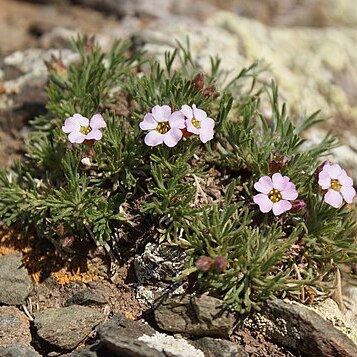Herbs, biennial or short-lived [long-lived] perennial, [0.3–]0.6–3 dm, hispid-hirsute, soft-hairy, and stipitate-glandular [eglandular]; taproots woody, scaly. Stems 1(–10), ?reddish tinged [green]?, simple or branched throughout, branches ascending or erect. Leaves basal winter-persistent, basal and cauline, rosulate, alternate, pinnately compound or simple and deeply pinnatifid; stipules absent; petiole present; blade obovate, 1.5–4 cm, herbaceous, 2–4-ternate, ?cauline sessile or petioles to 2 mm?, blade 1–2-pinnate or-pinnatifid, lobes linear-oblong, margins flat, entire, venation pinnate, ?1 vein per lobe (lateral veins not seen)?, surfaces hairy, stipitate-[or sessile] glandular. Inflorescences terminal or often axillary, 10–many-flowered, crowded [sparse], flat-topped panicles; ?peduncles present?; bracts present; bracteoles absent. Pedicels present or nearly absent [long-pedicellate]. Flowers 2–4[–4.5] mm diam.; epicalyx bractlets 5, reduced to bristles proximal to sepal bases; hypanthium campanulate, 1.5–2.5[–3.5] mm, exterior shiny-bristled, adaxially sparsely villous at rim; sepals 5, erect-ascending [recurved], ovate-lanceolate [triangular], ?bristle-tipped?; petals 5, white, obovate or cuneate-oblong, ?apex emarginate?; stamens 5(or 6), shorter than petals; torus absent; carpels 5–10(–20), glabrous, styles lateral; ovule 1. Fruits aggregated achenes, 1–6, ?olivaceous to blackish [reddish to purplish at base]?, ovoid-pyriform, 1.1–1.4[–1.6] mm, glabrous; hypanthium persistent; sepals persistent, erect-ascending (recurved); styles persistent. x = 7.
More
Herbs or subshrubs, glandular pilose or pubescent. Flowering stems erect, slender. Leaves alternate; stipules membranous at base, adnate to petiole; leaf blade 1–3 times 3-parted into narrow segments. Inflorescence cymose, corymbose, or paniculate, rarely a solitary flower. Flowers small. Hypanthium obconic, tubular, or campanulate. Sepals 5, erect, valvate, persistent. Petals 5, white or purple. Disk lining mouth of hypanthium, setose with long, rigid hairs, margin thickened. Stamens 5, opposite petals. Carpels 4–10 or more; ovule ascending from base of locule; style basal, articulate at base, deciduous; stigma capitellate. Achenes few or many, ovoid, glabrous, enclosed by hypanthium. Seed erect.
Hypanthium saucer-shaped; sep 5; bractlets none; pet 5, cuneate-obovate; stamens 5, opposite the pet, with short filaments; ovaries 5–10, rarely more; ovule ascending; style nearly basal, slender, jointed below; fr an achene; taprooted perennial herbs with ternately decompound cauline lvs and ample bracteate cymes of numerous small, white or purplish fls. 5, all but ours strictly Siberian.

